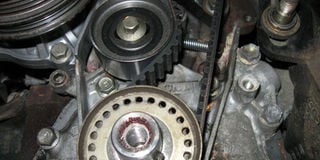What is a timing belt and when should you replace it?

A timing belt is made of a reinforced rubber composite, and can include highly durable materials such as kevlar to prolong its lifespan. PHOTO / ABUBAKER LUBOWA
What you need to know:
Replacing the timing belt is an important maintenance item. So, if you own a car, you should understand how a timing belt works and when to replace it.
For your engine to start, there has to be a perfect timing for every part, especially the engine valves. Depending on the car model, other parts have to move at the same time for the engine to start. If the timing is wrong, which is put together by the timing belt, it will not start.
Steven Mukasa, a mechanic, defines a timing belt as a circular rubber ring with teeth on the inner part. It wears into gears, with each gear in one tooth or place. The purpose of the teeth on the timing belt is to hold gears together to avoid any movement. If it moves and one tooth is in the wrong place, it will break. After breaking, many parts go out of sync.
“The process of timing varies from one car to another. The timing belts ensure different parts are synchronised correctly to allow all parts move in unison to complete the engine combustion cycle. There are parts called timing marks that are always indicated in most cars and all these and tensioners and idlers have to be in sync with the engine,” Mukasa explains.
Timing chains
Some cars use timing chains. The difference is that the belt is rubber while the chain is metallic, like a bicycle chain. The location of the belt or chain vary from one vehicle brand to another. For instance, the Land Rover Discovery 1’s timing belt is at the front while the Discovery 2 has no belt; the Discovery 3 and other Land Rover Discovery diesel brands have both the chain and the belt. What timing chains do is reduce the burden on the belt. A timing chain lasts almost the lifetime of the engine.
The other difference between the timing belt and chain is that the chain is mounted inside the engine and is lubricated with oil, while the belt runs outside the engine.
“As the car runs, the belt is also running. It has to be of the best quality and is manufactured to run for approximately 100,000km. After this mileage, it is recommended to have it replaced. For the safety of your engine, do not attempt to start the car when the timing belt is broken. This is because many parts are not in sync and will get damaged,” Mukasa warns.
Parts to replace
William Kyazze, a mechanic, advises that upon replacing the belt at 100,000km, other parts such as idlers and tensioners should also be replaced.
“As the timing belt runs, it rotates against metals and wears out gradually. When you examine some timing belts, they could be eaten up and this could be that the bearing of the idler was worn out. This means you have to replace the entire tensioner and the idler to allow the belt move in a straight line. If you have not replaced the idler, your timing belt will not cover the next recommended (100,000km) mileage. The crankshaft gear that helps the belt and chain to move have to be in good condition,” Kyazze explains.
Driving habits
Some driving habits, such as poor braking, or bad downshifting will cause the timing belt to break. For instance, if you are driving at a high speed and you shift gears from gear five and end up in gear one in one go, the belt will either break or cause other problems on the rocker shafts. You are supposed to downshift from gear five to one but in order without skipping any.
Cost of replacement
The replacement cost of a broken belt varies from one vehicle brand to another since they are of different sizes. On average, a timing belt ranges between Shs40,000 for smaller engines to Shs250,000 for big engines. With damaged valves and bush rods, you may pay up to Shs500,000 or more. To be on the safe side, it is important to note that when you buy a car, it is advisable to replace the timing belt.
The timing belt is one part that does not warn you before it breaks. The engine stops unexpectedly. It is supposed to be dry with no oil leakage at all. You have to look at oil seals, as the parts closer to the belt, and make sure they are tight.
If you do not replace the timing belt at the recommended time, you could end up with total engine failure, broken or bent valves, cylinder head or camshaft damage, and piston and cylinder wall damage. Therefore, replace the timing belt according to the manufacturer’s maintenance schedule to avoid thousands of shillings repairing or replacing your engine.
Signs
Often, there are no warning signs before a timing belt breaks. But here are some possible indicators that it might be time to replace your belt:
Decreased engine power.
Overheating.
Vibrating or shaking.
Trouble starting the vehicle.
Squealing or rubbing noises from the belts.
Ticking noise coming from the engine.
Leaking oil.
Check engine light.




